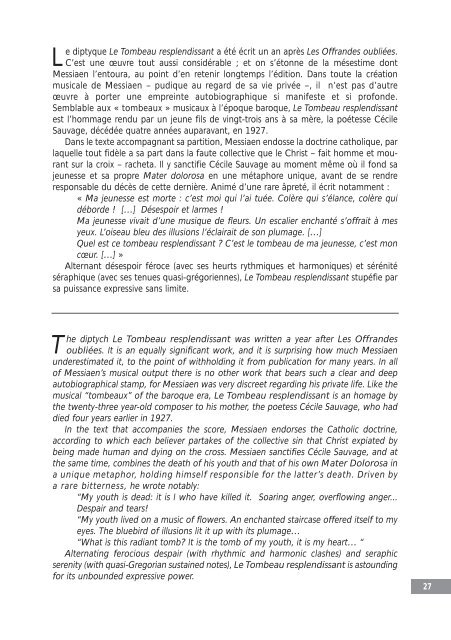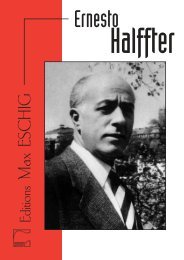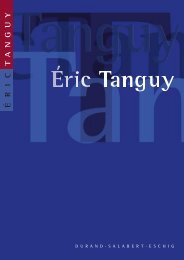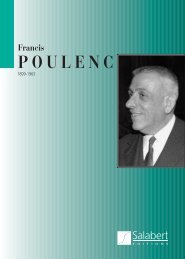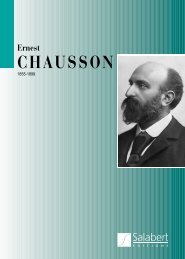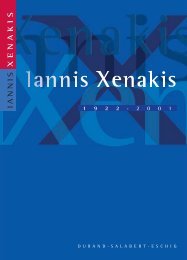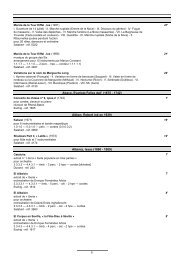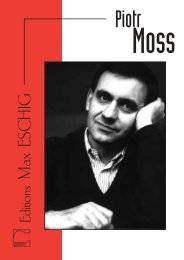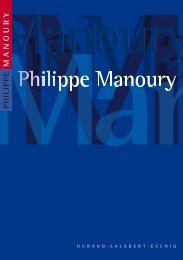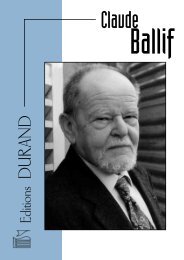messiaen olivier 1 9 0 8 - Durand Salabert Eschig
messiaen olivier 1 9 0 8 - Durand Salabert Eschig
messiaen olivier 1 9 0 8 - Durand Salabert Eschig
You also want an ePaper? Increase the reach of your titles
YUMPU automatically turns print PDFs into web optimized ePapers that Google loves.
Le diptyque Le Tombeau resplendissant a été écrit un an après Les Offrandes oubliées.<br />
C’est une œuvre tout aussi considérable ; et on s’étonne de la mésestime dont<br />
Messiaen l’entoura, au point d’en retenir longtemps l’édition. Dans toute la création<br />
musicale de Messiaen – pudique au regard de sa vie privée –, il n’est pas d’autre<br />
œuvre à porter une empreinte autobiographique si manifeste et si profonde.<br />
Semblable aux « tombeaux » musicaux à l’époque baroque, Le Tombeau resplendissant<br />
est l’hommage rendu par un jeune fils de vingt-trois ans à sa mère, la poétesse Cécile<br />
Sauvage, décédée quatre années auparavant, en 1927.<br />
Dans le texte accompagnant sa partition, Messiaen endosse la doctrine catholique, par<br />
laquelle tout fidèle a sa part dans la faute collective que le Christ – fait homme et mourant<br />
sur la croix – racheta. Il y sanctifie Cécile Sauvage au moment même où il fond sa<br />
jeunesse et sa propre Mater dolorosa en une métaphore unique, avant de se rendre<br />
responsable du décès de cette dernière. Animé d’une rare âpreté, il écrit notamment :<br />
« Ma jeunesse est morte : c’est moi qui l’ai tuée. Colère qui s’élance, colère qui<br />
déborde ! […] Désespoir et larmes !<br />
Ma jeunesse vivait d’une musique de fleurs. Un escalier enchanté s’offrait à mes<br />
yeux. L’oiseau bleu des illusions l’éclairait de son plumage. […]<br />
Quel est ce tombeau resplendissant ? C’est le tombeau de ma jeunesse, c’est mon<br />
cœur. […] »<br />
Alternant désespoir féroce (avec ses heurts rythmiques et harmoniques) et sérénité<br />
séraphique (avec ses tenues quasi-grégoriennes), Le Tombeau resplendissant stupéfie par<br />
sa puissance expressive sans limite.<br />
The diptych Le Tombeau resplendissant was written a year after Les Offrandes<br />
oubliées. It is an equally significant work, and it is surprising how much Messiaen<br />
underestimated it, to the point of withholding it from publication for many years. In all<br />
of Messiaen’s musical output there is no other work that bears such a clear and deep<br />
autobiographical stamp, for Messiaen was very discreet regarding his private life. Like the<br />
musical “tombeaux” of the baroque era, Le Tombeau resplendissant is an homage by<br />
the twenty-three year-old composer to his mother, the poetess Cécile Sauvage, who had<br />
died four years earlier in 1927.<br />
In the text that accompanies the score, Messiaen endorses the Catholic doctrine,<br />
according to which each believer partakes of the collective sin that Christ expiated by<br />
being made human and dying on the cross. Messiaen sanctifies Cécile Sauvage, and at<br />
the same time, combines the death of his youth and that of his own Mater Dolorosa in<br />
a unique metaphor, holding himself responsible for the latter’s death. Driven by<br />
a rare bitterness, he wrote notably:<br />
“My youth is dead: it is I who have killed it. Soaring anger, overflowing anger...<br />
Despair and tears!<br />
“My youth lived on a music of flowers. An enchanted staircase offered itself to my<br />
eyes. The bluebird of illusions lit it up with its plumage…<br />
“What is this radiant tomb? It is the tomb of my youth, it is my heart… “<br />
Alternating ferocious despair (with rhythmic and harmonic clashes) and seraphic<br />
serenity (with quasi-Gregorian sustained notes), Le Tombeau resplendissant is astounding<br />
for its unbounded expressive power.<br />
27


